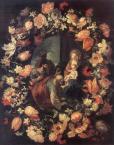The Meaning Behind Christmas Greenery


The hanging of greens stretches back before written history. Folktales come down to us of Norsemen pinning evergreen boughs over doorways to ward off evil. The greens were also taken indoors to freshen stale air and to freshen spirits during the long drear winter. And early in the 7th century, facing stiff competition from the long established Anglo-Saxon religious cults in England, Pope Gregory I instructed Augustine of Canterbury to incorporate any and all pagan customs into the Church--including the hanging of greens as long as it brought in converts.
The Christmas tree story begins in the 1300's, in northern Europe, when performers strolled the streets bearing huge pine boughs laden with apples. As walking advertisements for the miracle plays they staged on the church steps, the boughs represent the Garden of Eden in the play of Adam and Eve, traditionally performed on Dec. 24th. Gradually this "paradise" tree, as it was called, transmuted into the tree of life--the Christ Child's tree.
On of the first written references to a Christmas tree was in 1605 in Strasbourg, where a visitor reported seeing a tree decorated with apples, gilded candies, paper roses and thin wafers. The rose was the symbol of Mary the Virgin; the wafer represented the host of the Holy Communion, and the gilded candies were for children. The writer called the tree "Christbaum".
Two hundred years later, such a tree was brought to America by Germans settling in Pennsylvania. By 1848, the beloved little firs were selling in Philadelphia markets.
Evergreens were used for decorative and ceremonial purposes long before the birth of Christ. The Romans, during their Saturnalia, or winter festival, carried laurel, holly, and other greens in processions. They also decorated their homes and temples with garlands and flowers.
Holly is one of the most common of the Christmas greens. It is said to symbolize Christ's crown of thorns; its sharp, pointed leaves representing His wounds; and its red berries, His blood.
Mistletoe

Mistletoe is a plant of ancient legends. The Greeks once believed that its evergreen leaves were a symbol of good luck. The Druids considered the mistletoe sacred and thought it was effective against evil spirits and disease.
As years went by, the English ceremoniously cut the mistletoe that grew high in the trees and carried it home in large bundles. During the winter months, they hung it over their doors as a sign of good luck. Since only happiness could pass beneath the mistletoe, enemies would embrace and seal their peace with a kiss of friendship. This is probably where the custom today originated that anyone caught beneath the mistletoe must be kissed.
Christmas With Love Hosted and Written by (unless otherwise specified) Jaci Rae.
Copyright, Jaci Rae and North Shore Records, Inc.


